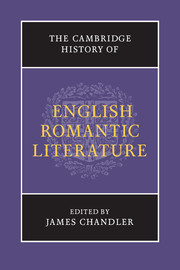Book contents
- Frontmatter
- Introduction
- Part I The Ends of Enlightenment
- Part II Geographies: The Scenes of Literary Life
- Part III Histories: Writing in the New Movements
- 15 Rebellion, revolution, reform: the transit of the intellectuals
- 16 Changes in the world of publishing
- 17 The new poetries
- 18 Romanticism and poetic autonomy
- 19 Transformations of the novel – I
- 20 Transformations of the novel – II
- 21 Theatre, performance and urban spectacle
- 22 The epigenesis of genre: new forms from old
- 23 The literature of the new sciences
- 24 The making of child readers
- Part IV The Ends of Romanticism
- Chronology
- Bibliographies
- Index
- 1 A New Pocket Map of the Cities of London and Westminster; with the Borough of Southwark, Comprehending the new Buildings and other Alterations, 3rd edn (London: William Faden, 1790).">
- References
23 - The literature of the new sciences
from Part III - Histories: Writing in the New Movements
Published online by Cambridge University Press: 28 May 2009
- Frontmatter
- Introduction
- Part I The Ends of Enlightenment
- Part II Geographies: The Scenes of Literary Life
- Part III Histories: Writing in the New Movements
- 15 Rebellion, revolution, reform: the transit of the intellectuals
- 16 Changes in the world of publishing
- 17 The new poetries
- 18 Romanticism and poetic autonomy
- 19 Transformations of the novel – I
- 20 Transformations of the novel – II
- 21 Theatre, performance and urban spectacle
- 22 The epigenesis of genre: new forms from old
- 23 The literature of the new sciences
- 24 The making of child readers
- Part IV The Ends of Romanticism
- Chronology
- Bibliographies
- Index
- 1 A New Pocket Map of the Cities of London and Westminster; with the Borough of Southwark, Comprehending the new Buildings and other Alterations, 3rd edn (London: William Faden, 1790).">
- References
Summary
Introduction
The period of the late eighteenth and early nineteenth centuries, familiar to students of literature as the age of Romanticism, has been named by some historians of science ‘the second Scientific Revolution’. The suggestion is of a transformation comparable in significance to the seventeenth-century movement in which Galileo, Descartes and Newton played prominent roles. In the earlier period, the earth had been recognized as a planet orbiting the sun, and natural philosophy reshaped by applying experimental and mathematical methods. The later period saw the emergence of new scientific disciplines, including geology, biology and physiology, and the reconfiguration of existing ones, especially physics and chemistry. Changes in disciplinary practices coincided with fundamental changes in scientific institutions. In Britain, the period also saw vigorous development of new means of popularization and new audiences; science attained a higher profile in the eyes of the general public than it had hitherto enjoyed. Scientific ideas circulated in general literate culture, communicated by public lectures in London and the provinces and periodicals and books addressed to middle-class readers. They even achieved a currency in working-class circles through the efforts of journalists, publishers and educators. The ‘scientist’ – to adopt the new term, first proposed by William Whewell at a meeting of the British Association for the Advancement of Science in 1833 – was a figure in the public eye.
Keywords
- Type
- Chapter
- Information
- The Cambridge History of English Romantic Literature , pp. 527 - 552Publisher: Cambridge University PressPrint publication year: 2009



